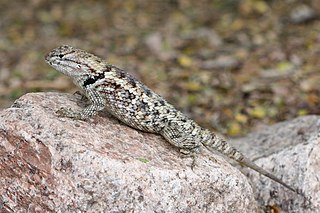
The Phrynosomatidae are a diverse family of lizards, sometimes classified as a subfamily (Phrynosomatinae), found from Panama to the extreme south of Canada. Many members of the group are adapted to life in hot, sandy deserts, although the spiny lizards prefer rocky deserts or even relatively moist forest edges, and the short-horned lizard lives in prairie or sagebrush environments. The group includes both egg-laying and viviparous species, with the latter being more common in species living at high elevations.

The Iguanidae is a family of lizards composed of the iguanas, chuckwallas, and their prehistoric relatives, including the widespread green iguana.

Phrynosoma, whose members are known as the horned lizards, horny toads, or horntoads, is a genus of North American lizards and the type genus of the family Phrynosomatidae. Their common names refer directly to their horns or to their flattened, rounded bodies, and blunt snouts.

Spiny lizards is a common name for the genus Sceloporus in the family Phrynosomatidae. The genus is endemic to North America, with various species ranging from New York, to Washington, and one occurring as far south as northern Panama. The greatest diversity is found in Mexico. This genus includes some of the most commonly seen lizards in the United States. Other common names for lizards in this genus include fence lizards, scaly lizards, bunchgrass lizards, and swifts.

The western fence lizard is a common lizard of Arizona, New Mexico, California, Idaho, Nevada, Oregon, Utah, Washington, Northern Mexico, and the surrounding area. As the ventral abdomen of an adult is characteristically blue, it is also known as the blue-belly.

The Greater Short-Horned Lizard, also commonly known as the Mountain Short-Horned Lizard, is a species of lizard endemic to western North America. Like other horned lizards, it is often called a "horned toad" or "horny toad", but it is not a toad at all. It is a reptile, not an amphibian. It is one of seven native species of lizards in Canada.

The Texas horned lizard is one of about 21 North American species of spikey-bodied reptiles called horned lizards, all belonging the genus Phrynosoma. It occurs in south-central regions of the US and northeastern Mexico, as well as several isolated introduced records and populations from Southern United States. Though some populations are stable, severe population declines have occurred in many areas of Texas and Oklahoma. The Texas spiny lizard may be confused for a Texas horned lizard due to its appearance and overlapping habitat.

The desert horned lizard is a species of phrynosomatid lizard native to western North America. They are often referred to as "horny toads", although they are not toads, but lizards.

The short-tailed horned lizard is a species of lizard in the family Phrynosomatidae. The species is endemic to Mexico. It has a very distinct, shortened tail, which is sometimes not apparent.

Sceloporus magister, also known as the desert spiny lizard, is a lizard species of the family Phrynosomatidae, native to the Chihuahuan Desert and Sonoran Desert of North America.
The rock horned lizard, also known commonly as Ditmars' horned lizard and camaleón de roca in Mexican Spanish, is a species of lizard in the family Phrynosomatidae. The species is endemic to the Mexican state of Sonora, in northern Mexico, south of the Arizona border. Bearing the shortest horns of all the horned lizards, it lives in thorn-scrub and deciduous Sinaloan woodlands. The rock horned lizard was "lost" to science for about 65 years. It has a unique habitat preference and limited distribution. It also had a very imprecise holotype locality record which made it difficult to locate. An extraordinary effort by Vincent Roth based on a cross-correlational analysis of gut contents from only three specimens led to its rediscovery.

The flat-tail horned lizard is a species of lizard in the family Phrynosomatidae. A species of reptile, it is endemic to the Sonoran desert of the southwestern United States and northwestern Mexico. Its multiple adaptations for camouflage help to minimize its shadow. The species is threatened, with a restricted range under pressure from human activities such as agriculture and development, and is specially protected in the United States.

The Mexican Plateau horned lizard is a species of horned lizard in the family Phrynosomatidae. The species, also known commonly as the Chihuahua Desert horned lizard, is endemic to Mexico. There are five recognized subspecies. The specific epithet, orbiculare, comes from the Latin adjective orbis, meaning "circular".

The pygmy short-horned lizard is a species of small horned lizard in the family Phrynosomatidae. The species is native to the northwestern United States and adjacent southwestern Canada. Like other horned lizards, it is often called a "horned toad" or "horny toad," but it is not a toad at all. It is a reptile, not an amphibian.

The San Diego horned lizard or Blainville's horned lizard is a species of phrynosomatid lizard native to southern and central California in the United States and northern Baja California in Mexico.
Baur's short-horned lizard is a species of small horned lizard that is endemic to the United States.















